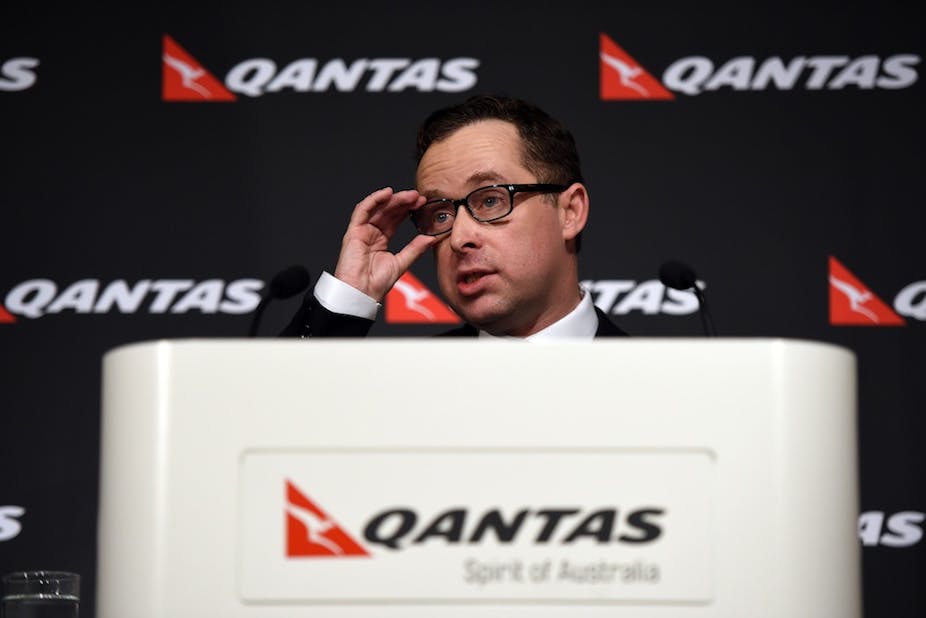Since becoming CEO in November 2008, Alan Joyce has led Qantas through one crisis after another: the global shut-down of operations in the 2011 industrial dispute; a major downgrade of Qantas credit rating; the decision to abandon its Singapore hub in favour of Dubai; thousands of job losses… and, now, the mother of all operating losses.
He has faced ongoing and persistent criticism from unions, industry experts, shareholders and loyal customers. Since taking on the top job, Joyce has overseen net after-tax losses of more than $2.5 billion.
Not surprisingly, calls for his head have only intensified over the last week.
Writing in Fairfax Media last week, Adele Ferguson suggested that Joyce has become “one of the most disliked chief executives since Telstra’s Sol Trujillo”.
But to blame Alan Joyce for Qantas’ current predicament seems somewhat simplistic, and misunderstands the challenges he face as the leader of one of Australia’s most iconic brands.
There have been a number strategic blunders, to be sure.
The decision to shut down Qantas operations in a standoff with unions still looks like a bad decision. While it expedited a resolution to the immediate strike action, it did not produce the major workplace reforms Qantas had hoped to achieve. Nor did it impress customers.
Going hand-in-cap to the federal government seeking a bailout in 2013 did not go down well with government or the general public. Qantas certainly needed a cash injection, but surely not a handout.
Nor has the company moved fast enough to restructure its internal operations and improve efficiency. Instead of focusing on accelerating change that would yield operational efficiencies, Qantas engaged in a destructive price war with Virgin Australia – a strategy that has is in part been responsible for the disastrous results announced last week.
However, a lot that has gone wrong over at Qantas can hardly be laid at the feet of Alan Joyce. In many ways he has faced a perfect storm in which the conflation of domestic and international challenges have all worked against his attempts to turn around the airline.
Internationally, new no-frills and low-frills carriers, especially in Asia, have eaten away at Qantas’ ability to compete as a full-service operator. Like Qantas, legacy carriers around the world are losing money. All of them have been scrambling to reduce operating costs and regain market share. Qantas has faced a particularly intense challenge in Asia and the Middle East where most major international carriers operate as fully or partially state-owned businesses, or benefit from subsidies and tax concessions.
For some of Qantas’ major regional competitors, their business model is as much driven by the imperative to promote domestic tourism, as it is by the need to run a profitable airline. Add to this the high Australian dollar, which affects the costs associated with major inputs such as fuel, revenues generated in foreign currency, and the value of its asset base.
The question remains, however, is Alan Joyce the right person to lead the Qantas turnaround?
I think there are good reasons to conclude that – at least for now – he is Qantas’ best bet. To begin with, Joyce appears to have the full backing of his Chairman, the Board and its major shareholders. This will be critical for any CEO expected to turnaround a business from the position Qantas now faces.
Although slow in coming, the CEO and the Board have articulated a clear strategy for turn-around, and begun to implement it. Qantas is now in the middle of major restructure which will see a freeze on expanding capacity in its domestic operations, the formal separation of its domestic and international operations into separate business units, and a significant reduction in its staff numbers. So far it has managed to deliver on this strategy. With full implementation of these changes, Qantas expects to be back in profitable territory within 12 months.
Joyce will need to do more than just catch up with competitors. Other operational changes will be required. Jetstar is bleeding money on both its domestic and international operations, and is failing to keep pace with innovations in the low cost sector.
Qantas also faces ongoing pressure to compete in the full service sector, where other carriers are experimenting with different passenger load models and have manage to utilise their aircraft fair more efficiently and profitably. This is a key difference, for example, between Qantas and Air New Zealand, which this week posted a $NZ262 million profit. It will also need to work out how to respond to what may be an emerging regional war in the Asia Pacific for its lucrative business travel market.
In an industry notorious for thin margins it is not hard to see why the business of running an airline is getting harder and harder. But in many respects, the most costly phase of the turn-around strategy now underway in Qantas is close to complete. But few pundits can see light at the end of the tunnel.
Right now, more than anything, Qantas may need Joyce’s leadership and dogged focus on implementing tough change if it is to find its way back to profitability. If he manages to pull off his ambitious plans for Qantas, Joyce may quickly go from being one of the most criticised business leaders in the country to one of the most admired. If he cannot do so, then along with the Chairman and other Board members, he will need admit failure and move on.

